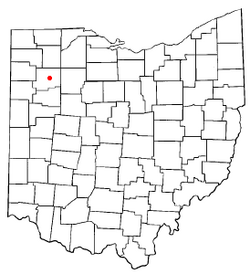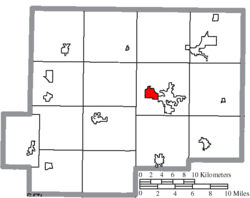Glandorf, Ohio facts for kids
Quick facts for kids
Glandorf, Ohio
|
|
|---|---|
|
Village
|
|

Location of Glandorf, Ohio
|
|

Location of Glandorf in Putnam County
|
|
| Country | United States |
| State | Ohio |
| County | Putnam |
| Township | Ottawa |
| Area | |
| • Total | 1.64 sq mi (4.24 km2) |
| • Land | 1.64 sq mi (4.24 km2) |
| • Water | 0.00 sq mi (0.00 km2) |
| Elevation | 722 ft (220 m) |
| Population
(2020)
|
|
| • Total | 969 |
| • Estimate
(2023)
|
974 |
| • Density | 592.30/sq mi (228.67/km2) |
| Time zone | UTC-5 (Eastern (EST)) |
| • Summer (DST) | UTC-4 (EDT) |
| ZIP code |
45848
|
| Area code(s) | 419 |
| FIPS code | 39-30282 |
| GNIS feature ID | 2398967 |
Glandorf is a small village located in Putnam County, Ohio, in the United States. In 2020, about 969 people lived there.
Contents
History of Glandorf
Glandorf was started in 1834 by Johann Wilhelm Horstmann and six other men. They traveled all the way from a town called Glandorf in Germany. They sailed on a ship called the Columbus in 1833 and arrived in New York. After that, they bought land in Putnam County, Ohio.
These first settlers included Johann F. Kahle, Wilhelm Gülker, Christian Strop, F. Wischmann, Friedrich Bredeick, and Mathias and Friedrich Bockrath. Johann Kahle bought land nearby and named it "Maria Camp." Horstmann's land became Glandorf. Their wives and ten more families from Germany joined them in 1834. Many more people from Germany came to Ohio and other parts of the U.S. after this. When Horstmann passed away in 1843, he left his land to the community.
In 1834, Horstmann built a simple log house. This building was used as a church, a school, and a home for the priest. The new church was named after St. John the Baptist. In 1835, a wooden church with a bell and a special pulpit replaced the log house. Later, a brick church was built between 1846 and 1848.
The beautiful St. John the Baptist church, which you can see today, was built in 1878. It was officially opened on December 15 of that year. In 1992, a fire damaged part of the church, but it was repaired and repainted.
A group of German sisters, called the Society of the Precious Blood, started a convent in Glandorf in 1849. They helped farm the land that Horstmann had owned and also worked as teachers. The convent closed in 1917.
-
St. John the Baptist church with a monument to Johann Wilhelm Horstmann
Geography of Glandorf
Glandorf is a small village. It covers an area of about 1.62 square miles (4.24 square kilometers). All of this area is land; there are no large bodies of water within the village limits.
Population and People
| Historical population | |||
|---|---|---|---|
| Census | Pop. | %± | |
| 1890 | 571 | — | |
| 1900 | 749 | 31.2% | |
| 1910 | 558 | −25.5% | |
| 1920 | 499 | −10.6% | |
| 1930 | 455 | −8.8% | |
| 1940 | 483 | 6.2% | |
| 1950 | 479 | −0.8% | |
| 1960 | 747 | 55.9% | |
| 1970 | 732 | −2.0% | |
| 1980 | 746 | 1.9% | |
| 1990 | 829 | 11.1% | |
| 2000 | 919 | 10.9% | |
| 2010 | 1,001 | 8.9% | |
| 2020 | 969 | −3.2% | |
| 2023 (est.) | 974 | −2.7% | |
| U.S. Decennial Census | |||
Most people in Glandorf speak English. A small number of people, about 3.8%, also speak German.
Glandorf Population in 2010
In 2010, there were 1,001 people living in Glandorf. These people lived in 340 households, and 263 of these were families. The village had about 618 people per square mile (239 people per square kilometer).
Most of the people living in Glandorf were White (98.3%). About 1.6% of the population identified as Hispanic or Latino.
Out of the 340 households, about 40.6% had children under 18 living with them. Most households (70.3%) were married couples living together. The average household had about 2.81 people, and the average family had about 3.30 people.
The average age of people in the village was 38.8 years old. About 28.6% of residents were under 18. About 15.9% of residents were 65 years old or older. Slightly more than half of the residents (52.7%) were female, and 47.3% were male.
Education in Glandorf
The local schools are part of the Ottawa-Glandorf Local Schools district. Glandorf Elementary School is located right in the village.
See also
 In Spanish: Glandorf (Ohio) para niños
In Spanish: Glandorf (Ohio) para niños





